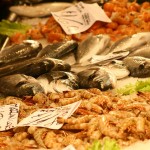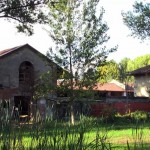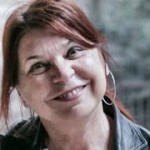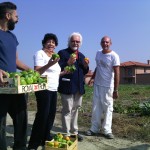Do you know how to recognize fresh fish?
Milan: The Earth Market
Every first and third Saturday of the month
The Earth Market takes place every first and third Saturday of the month right in the centre of Milan, in what was once the “Fabbrica del Vapore” (Steam Factory) .
It is a market of farm producers from the province of Milan and the surrounding areas, who only sell products produced by them, selected according to specific organoleptic or technological standards.
Milan is an agricultural city, you know!
⇒ Watch the full web serie: Green Milan Slow Tour
Visit Turismo Milano official website
Video full text: The Earth Market in Milan
On our cycling-agricultural journey
we have seen where the historical agricultural traditions of Milan are rooted.
We’ve seen projects that look to the future.
Real agricultural concerns with cattle farms and permanent meadows (in Italian marcite) literally inside the city.
OK, but where does one eat? Here! At the mercato della terra or earth market.
Right in the centre of Milan, in what was once the Fabbrica del Vapore (Steam Factory),
where the producers hold a market every first and third Saturday of the month.
Alessandro Cecchini is from Slow Food Milan.
What type of market is this? Who are the sellers here?
It’s a market of farm producers from the province of Milan and the surrounding areas.
They only sell products produced by them.
But who certifies the quality of these producers? Is it good stuff?
We’ve paid a visit to each individual farm that is here today,
and in order to be present in this market they have to adhere to the guidelines
drawn up by the Slow Food scientific committee,
where every individual production is detailed,
and must meet specific organoleptic or technological standards.
There is a sort of direct human relational guarantee.
Anyone can go and visit the farm directly.
Milan is an agricultural city, even historically speaking!
The essential thing for the earth market is the local component, and not just of the food,
but also with regard to the relationship with the producers.
Everyone here is interesting and has their own story.
Giancarlo comes from the Brianza and runs Vericultura, an organic natural farming business.
We imitate the undergrowth, where the raspberries and bilberries grow on the mountain.
Everything that grows spontaneously is very good,
therefore ours is not an neat fruit garden, it’s totally chaotic! But it is natural.
Then there’s Carlo, an organic intellectual, in every sense of the word,
who puts his intellect to work on the farm.
My farming methods are far from intensive
we’ve built a mobile henhouse, and my hens are put out to pasture.
You have salamis and cotechini (type of sausage), so I imagine that you also breed pigs.
A semi-wild breeding environment where the pigs are sacrificed
after their first birthday, usually at around 14 months.
Normally a pig is slaughtered at around 7 months, as is the case, for example, with Parma Ham.
A pig eats a bit of everything,
we don’t throw any of the pig away, but it, in turn, throws nothing away!
Irene has a real business that produces things, but primarily human relationships.
Social initiatives to bring producers and consumer closer together.
I set out with the idea that getting close to the land is good for one’s health,
and not just physical, because eating organic food means eating healthy,
but also ethical, because we’re all human beings,
living creatures that feed off their contact with nature,
beginning with children.
Stimulating the consumer to prioritise food.
The right question is not ‘why does a genuine farmer’s product cost so much?’,
but rather ‘why does what I buy at the supermarket cost so little?’
What’s the link between global and local?
According to Chiara the link is the goat.
Tell me about this cheese.
It is a toma (semi hard cheese), made from pure, raw goat’s milk.
I’m seeing things. I see a goat! I can hear it, I can smell it.
I hope that you can also smell the grass that the goats have eaten in that cheese,
because that’s how it ought to be.
They spent six months at Expo asking themselves how to feed the planet.
What do you think the recipe is?
I am very biased, so I believe in a network of small producers
who work in the area, moving around, shipping their products as quickly as they can.
But there must be traceability, the possibility of describing what one does.
You don’t think powdered milk is a good idea then, am I right?
Absolutely, but then I am biased!
Paolo Bolzacchini is from Slow Food.
We are putting together a tourist type itinerary,
and we have to show potential tourists, Italians, foreigners and even the Milanese,
those monuments that are worth visiting.This famous Parco Agricolo Sud Milano is considered a territorial monument.
In what way can a park be considered a monument?
An agricultural park is a belt of green land close to the city,
and in addition to the beauty of certain agricultural areas, there are also some veritable items of cultural heritage.
Historical abbeys like Chiaravalle.
The Parco Agricolo Sud Milano becomes a network of relationships
that you have attempted to organise with the Nutrire Milano (Feeding Milan) project.
The project was a provocation.
When Milan was awarded Expo, Carlo Petrini wrote a provocative article:
Is the agricultural city of Milan capable of feeding itself?
Something of a revolution.
We wanted to find the more upstanding businesses,
that were capable of bringing their food directly to the city.
Our journey through agricultural Milan ends here.
It has been a journey covering history, education, monuments and one of self-education.
A tourism trail through wine and gastronomy!
Visit Milan: helpful hints
Italian name: Milano
Arrival
Milan has got three airports:
- Malpensa Airport is the largest international & intecontinental Airport in Northern Italy. 30 miles Northwest from the city centre. Connections:
→ Train Malpensa Express: trains leaves every 30 minutes in each direction, connecting the Airport to Milan Grand Central Station or Cadorna Railway Station. Terminals 1 and 2. It takes 45 min, price: 14 €
→ Shuttle Bus: Malpensa Shuttle and Malpensa Bus Express connect the airport to Milan Grand Central Railway Station and Milan’s Underground Network. Terminals 1 and 2. It takes 60/70 min, price: 8 € - City Airport Linate is an international airport connecting Milan with main European cities, located just 4 miles from the city centre. Connections by shuttle: Atm Bus n. 73 from Milano Duomo M1 – M3 (Piazza Diaz, direction: San Babila), first ride at 5.35 am, last one at 00.35. Frequency: every 10 min, price 1,5 €
- Milan Bergamo Airport Orio al Serio is mainly low cost flights Airport, located 30 miles Northwest from Milan. Connections only by Shuttle: There are 4 different bus companies, pricing changes from 5 up to 8 €
Transports
ATM is Milan public transport service both for bus, tram and subway. Single ticket costs 1.50€ for 90-min ride. Consider daily/weekly subscriptions. You can buy tickets also texting to 48444. Milan Subway is the longest in Italy, covering 95 km: Donwload and check the map.
Moving in town can be nice also by bike: Milan has got a powerfull bike sharing service providing both regular and e-bikes. Here is the experience of our Ambassador Kim Harding with BikeMi service and a useful video of our Ambassador Roxana explaining how does it work. Car Sharing is also good with many different companies to choose.
Try also the local urban railway train, called Passante Ferroviario, check the experience of our Ambassador Roxana Iacoban travelling by local train in town.
What to do in Milan
Milan is the Italian financial center and one of the European capitals of Fashion. Known for its nightlife as well.
Some tips on Italia Slow Tour: watch our web serie about Leonardo da Vinci’s places, climb on top of the Duomo, visit Prada Foundation, Museums and Art Galleries, taste some fine gelato and try the local Aperitivo and – not joking – enjoy a sailing trip (!!) or some time deep in the nature close to some actual farms and fields.
Where to sleep
Accomodations are quite expensive in Milan, fares rise up and hotels get full according to the rich event calendar of the city (see: Fashion Week, Salone del mobile, Big concerts, Theatre and Sport events, etc.). If you are not specifically interested in any of those, try to travel during other periods to save some money.
Italia Slow Tour recommends:
- Hotel Cervo in Garibaldi District if you want to stay close to city centre and enjoy the nightlife
- Hotel Concorde located on the Green Way Milan-Lecco to Lake Como, if you want to move around adn travel by bike
Shopping in Milan
The famous Fashion District involves the following streets/areas: Via Montenapoleone, via Manzoni, via della Spiga and Corso Venezia. The so called “Quadrilateral of Fashion”. Here you can find all kind of brands and shops. Easy to reach by Subway (stop at Montenapoleone station).
Don’t miss the Street Markets! Almost every day you can find one: best are the ones in Viale Papiniano (on Tuesday) and Via Fauchè (on Saturday). More on the official website of weekly street markets. If you are into sustainable local products, Milan has got 8 actual farms in town and a green Earth Market.
If you are interested in Outlet Shopping, in the outskirt of Milan you can find 4 different Fashion Outlets, in a radius of 62 miles. Here you can find everyday a lot of famous high quality Italian brands on sale, with prices cut off up to 50%. All the outlets are connected to the center of Milan by Shuttle Bus:
- Serravalle Designer Outlet – Shuttle departure from Milan Central Station or Cairoli square
- Fidenza Village Outlet Shopping – Shuttle departure from Piazza della Repubblica 5, at the corner with Turati st.
- Vicolungo The Style Outlets – Shuttle departure from Cairoli square
- Rodengo-Saiano Franciacorta Outlet Village – Shuttle departure from Cairoli square














